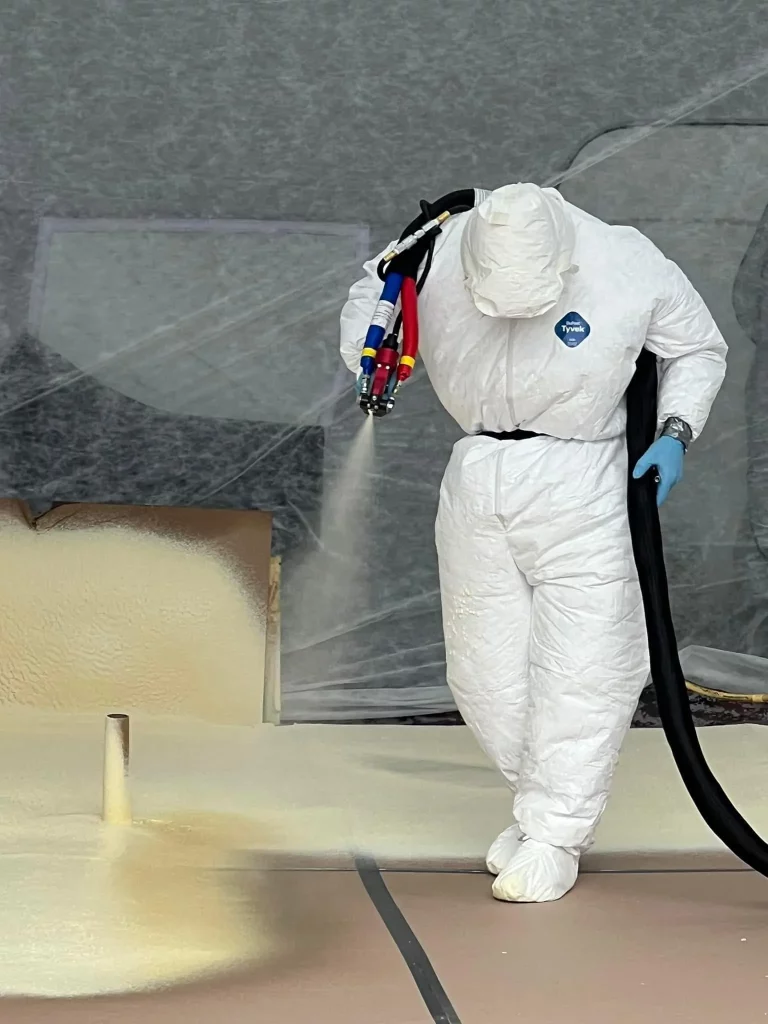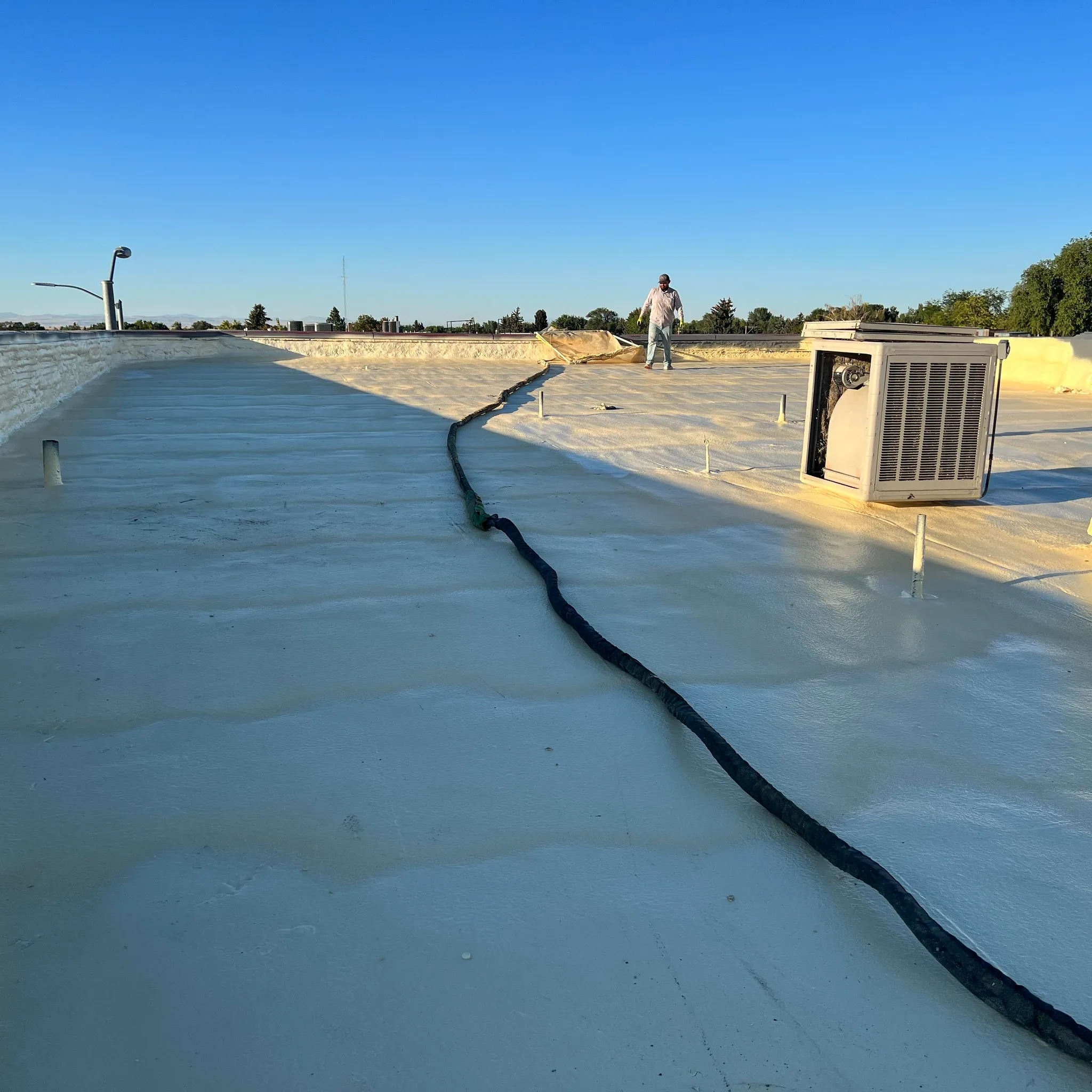Spray foam roofing systems typically last 20 to 30 years when properly installed and maintained. The exact lifespan depends on factors such as UV exposure, maintenance frequency, climate conditions, and the quality of the installation. In dry regions like Idaho, with low annual rainfall and high sun exposure, the upper end of that range is common when protective coatings are re-applied at appropriate intervals.
The performance of Spray foam roofing Insulation over time is directly linked to routine maintenance and re-coating cycles. A correctly applied elastomeric topcoat must be inspected and re-applied every 10-15 years. Without this, the foam can degrade prematurely under UV radiation. Most failures occur not due to material issues, but from neglected upkeep.
Information provided here is based on extensive experience working with spray foam systems across Idaho’s commercial and residential sectors, combined with performance benchmarks published by industry leaders like the Spray Polyurethane Foam Alliance (SPFA).
Key Performance Details and Technical Data
| Feature | Specification / Range |
|---|---|
| Average Lifespan | 20-30 years |
| Maintenance Interval | Every 10-15 years |
| Initial R-Value | R-6.5 to R-7 per inch |
| UV Resistance | Requires protective topcoat |
| Waterproofing Capability | Fully sealed, monolithic surface |
| Re-coat Requirement | Elastomeric re-coat every 10-15 years |
| Common Coating Materials | Silicone, Acrylic |
| Ideal Application Thickness | 1.5″ to 2.5″ depending on project specs |
| Thermal Performance Loss | Minimal if coatings are maintained |

Performance in Idaho’s Climate
Dry summers and cold winters in southern Idaho create sharp temperature swings that stress conventional roofing systems. Spray foam roofs manage this better than layered systems due to their monolithic application and low thermal conductivity. Foam’s closed-cell structure prevents moisture infiltration even after years of service.
Bonus Tip: High-elevation buildings benefit from a white or reflective coating to reduce UV degradation and lower roof temperatures during peak summer months.
Practical Comparison of Roofing Options
| Roofing System | Lifespan (yrs) | Seamless | Insulating | Requires Tear-Off | Maintenance Type |
|---|---|---|---|---|---|
| Spray Foam | 20-30 | Yes | Yes | No | Re-coating every 10-15 yrs |
| TPO Single Ply | 15-25 | No | Moderate | Sometimes | Seams & flashing upkeep |
| Built-Up Roofing | 15-30 | No | Moderate | Often | Regular patching |
| Metal Roofing | 40+ | No | Low | Usually | Fastener & seam checks |
Things to Check Before Choosing Spray Foam Roofing
- Recoat Plan: Ensure long-term maintenance is planned, including inspections and recoating.
- Drainage Compatibility: Confirm that the roof slope and scuppers are suitable for foam application.
- Installer Experience: Improper application can result in ponding or uneven thickness.
- Coating Type: Choose coating based on regional climate and UV intensity.
- Building Usage: Consider foam’s energy benefits for temperature-sensitive operations like warehouses or food storage.
Bonus Tip: For re-roofing projects, spray foam often eliminates the need for a full tear-off, reducing labor and downtime.
Relevant Services Available
Valley Spray Works provides key spray foam insulation solutions specifically aligned with long-term roofing needs:
- Spray Foam Roof Insulation – Seamless, insulating, and waterproof systems installed for both new and existing roofs.
- Intumescent Coatings – Added fire resistance applied over foam where code requires it.
- Fluid Applied Vapor Barrier – Reinforces roof envelope against moisture vapor transmission.
- Thermal Insulation Coating – Enhances foam performance by increasing reflectivity and minimizing heat gain.
Questions People Ask Before Choosing
How often do spray foam roofs need maintenance?
Every 10-15 years, a new coating layer should be applied to maintain protection and lifespan.
Can spray foam be installed over existing roofing?
Yes. It adheres directly to most existing substrates without full tear-off, depending on structural condition.
What happens if foam is exposed to sunlight too long?
Unprotected foam will degrade from UV radiation, turning brittle and cracking within months. A topcoat is critical.
Is spray foam roofing appropriate for flat roofs?
Yes. Foam’s seamless application makes it especially effective for flat and low-slope roofs prone to pooling.
Final Thoughts on Spray Foam Roofing Durability
Spray foam roofing delivers consistent long-term performance when supported by routine re-coating and inspection. Its seamless installation, insulating quality, and adaptability to roof shapes give it strong advantages over many traditional systems. For buildings in Idaho’s high-UV and variable weather zones, it’s a reliable choice when managed with a long-term maintenance outlook.
Contact Valley Spray Works
To plan your next roofing upgrade or learn more about proper maintenance schedules, contact Valley Spray Works. For direct inquiries, call (208) 539-5281 or email [email protected]. Technicians are available to assess existing roofs and recommend practical timelines for inspection and service based on real building conditions.
Answers to Long-Term Use and Maintenance Questions
How long does a re-coated spray foam roof last?
Each re-coat cycle can add 10-15 years of life. With regular maintenance, systems may exceed 30 years total.
Does spray foam lose R-value over time?
Only if coatings are neglected and UV exposure occurs. Otherwise, R-value remains stable over decades.
Can spray foam roofs be repaired locally?
Yes. Damaged areas can be re-foamed or patched without needing full replacement.
How do I know when to re-coat?
Visual cues include discoloration, chalking, or cracking of the topcoat. A certified inspection confirms the condition.
Is spray foam safe for high-wind areas?
Yes, once cured, the foam adheres tightly to the substrate and resists wind uplift better than most single-ply systems.



